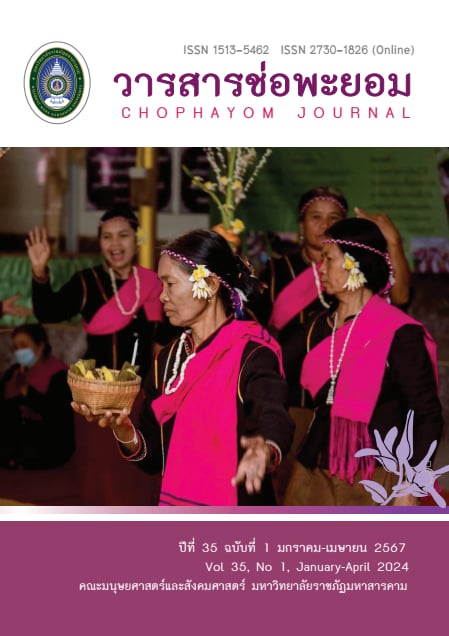Exploring Out-of-Class English Frequency and Preferences A Students
Keywords:
Out-Of-Class Activities, English Language Learning, English Major StudentsAbstract
Out-of-class English language learning plays a crucial role in enhancing language proficiency and fostering learner autonomy (Benson, 2011). Moreover, it allows students to take control of their language learning journey and develop lifelong skills beyond traditional classroom settings. This study investigated the frequency and preference of out-of-class English learning activities among English major students at Rajabhat Maha Sarakham University, Thailand. Applying purposive sampling, 249 students participated in the survey. A questionnaire, adapted from Cheng (2015) and Sun (2016) and translated into Thai, was employed. The analysis included the calculation of mean and standard deviation, with interpretation based on the Likert scale. The findings revealed that participants demonstrated a moderate frequency of participation in out-of-class activities. In terms of preferences, participants showed a neutral level of preference for out-of-class English learning activities.
In conclusion, the findings suggest that students should be encouraged to engage in out-of-class English language learning by suggesting different activities. It is important to find a balance between what students like and what they don't like for better language learning outside of the regular class.
Keywords: out-of-class activities, English language learning, English major students
References
Benson, P. (2007). Autonomy in language teaching and learning. Language Teaching,40(01), 21-40.
Benson, P., & Reinders, H. (Eds.). (2011). Beyond the language classroom. New York: Palgrave Macmillan.
Benson, P. (2011). Teaching and Researching: Autonomy in Language Learning. New York: Routledge.
Benson, P. (2013). Teaching and researching: Autonomy in language learning. New York: Routledge.
Brown, H. D. (2016). Principles of Language Learning and Teaching. England: Pearson.
Chapelle, C. A. (2001). Computer Applications in Second Language Acquisition: Foundations for Teaching, Testing, and Research. Cambridge: Cambridge University Press.
Cheng, C. M. (2015). Perceptions of and experiences with vocational college English majors’ out-of-class English learning in Taiwan. Journal of Language Teaching and Research, 6(4), 737-748.
Chusanachoti, R. (2009). EFL learning through language activities outside the classroom: A case study of English education students in Thailand. (Doctoral dissertation, Michigan State University).
Dulay, H., Burt, M., & Krashen, S. (1982). Language two. New York: Oxford University Press.
Ellis, R. (2008). The Study of Second Language Acquisition. Oxford: Oxford University Press.
Gardner, R. C. (2010). Motivation and Second Language Acquisition. New York: Peter Lang.
Holec, M. (1981). Autonomy and foreign language learning. Oxford: Pergamon.
Hyland, F. (2004). Learning autonomously: Contextualizing out of class English language learning. Language Awareness, 13(3), 180-202.
Kagan, S. (1995). We can talk: Cooperative Language Learning in the Elementary ESL classroom. In Wasanasomsith, P. (2003). A Case Study of Thai ESL Learners’ Language and Literacy Learning in an Authentic Situation: Opening a Bank Account. Chulalongkorn University Language Institute, Thailand.
Krashen, S. (1985). The input hypothesis: Issues and implications. New York: Longman.
Krejcie, R. V., & Morgan, D. W. (1970). Determining sample size for research activities. Educational and Psychological Measurement, 30(3), 607-610.
Lightbown, P. M., & Spada, N. (2013). How Languages are Learned. Oxford: Oxford University Press.
Little, D. (2009). Language learner autonomy and the European language portfolio: Two L2 English examples. Language Teaching, 42(2), 222-233.
Nunan, D. (1990). Understanding language classrooms: A guide for teacher-initiated action. London: Prentice-Hall International.
Oxford, R. L. (2011). Teaching and Researching: Language Learning Strategies. New York: Routledge.
Pearson (2004). The idiosyncrasies of out-of-class language learning: A study of mainland Chinese students studying English at tertiary level in New Zealand. In Proceedings of the Independent Learning Conference 2003.
Pickard, N. (1996). Out-of-class language learning strategies. ELT Journal, 50, 150-159.
Reid, J. (2005). Perceptual Learning Style and Learning Proficiency: A Test of the Hypothesis. In Learning Styles in the ESL/EFL Classroom. Michigan: University of Michigan Press.
Richards, J. C., & Rodgers, T. S. (2014). Approaches and Methods in Language Teaching. Cambridge: Cambridge University Press.
Rubin, J. (1975). What the "good language learner" can teach us. TESOL Quarterly, 9, 41-51.
Sun, S. (2016). Out of class English learning activities of the vocational education learners at Kampong Chheuteal high school, Kampong Thom Province, Kingdom of Cambodia. (Master’s thesis, Burapha University).
Sundqvist, P. (2009). Extramural English matters: Out of school English and its impact on Swedish ninth graders' oral proficiency and vocabulary. (Doctoral dissertation, Karlstad University).
Warschauer, M., & Healey, D. (1998). Computers and Language Learning: An Overview. Language Teaching, 31(02), 57-71.
Wu, M. M. (2012). Beliefs and out of class language learning of Chinese-speaking ESL learners in Hong Kong. New Horizons in Education, 60(1), 35-52.
Downloads
Published
How to Cite
Issue
Section
License
Copyright (c) 2024 Chophayom Journal

This work is licensed under a Creative Commons Attribution-NonCommercial-NoDerivatives 4.0 International License.






